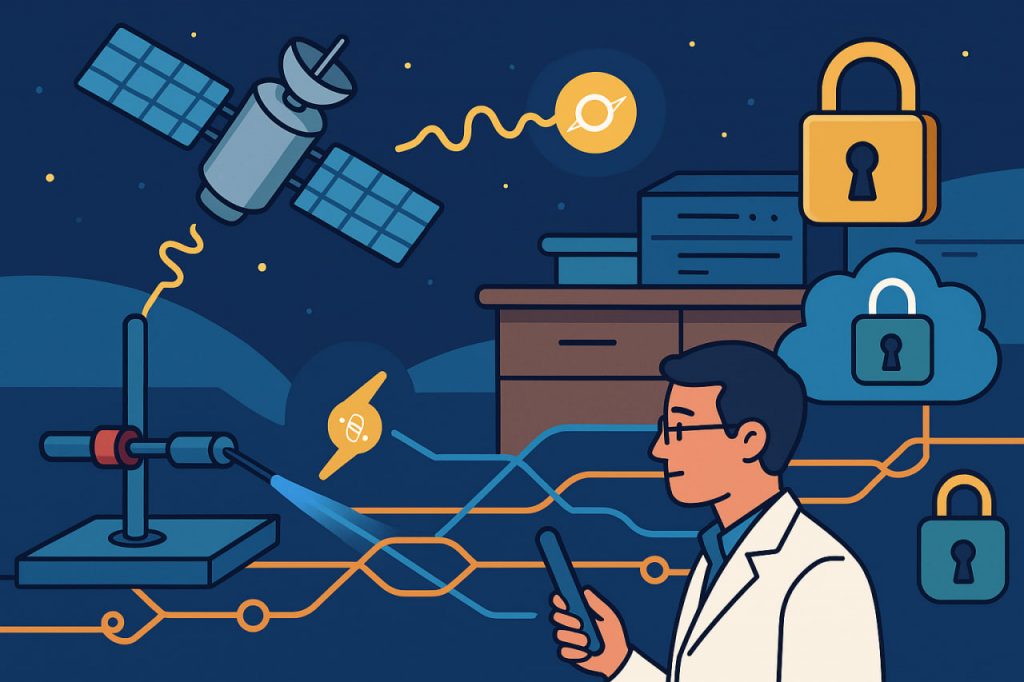Quantum cryptography is revolutionizing how sensitive information is secured. Based on the principles of quantum mechanics, this technology offers unbreakable encryption by exploiting the behavior of particles at the smallest scale. In recent years, major breakthroughs have brought quantum cryptographic methods closer to widespread practical use. As classical encryption systems become vulnerable to powerful quantum computers, quantum-based security may soon become essential for national security, finance, healthcare, and communications.
The Principles Behind Quantum Cryptography
Quantum cryptography relies on fundamental laws of physics, particularly the Heisenberg uncertainty principle and quantum superposition. These properties make it possible to detect any attempt to intercept or observe a communication channel. The most widely developed application is Quantum Key Distribution (QKD), where encryption keys are exchanged using entangled photons or single photons.
A key feature is that any eavesdropping attempt alters the quantum state of the particles, which can be detected immediately. This contrasts with classical encryption, where interception can go unnoticed. As a result, quantum cryptography promises provable security, not just computational difficulty.
Recent Technological Breakthroughs
In the past five years, researchers have achieved significant progress in making quantum cryptography scalable and practical. One major advancement is the development of satellite-based QKD, demonstrated by China’s Micius satellite, which successfully transmitted quantum keys between continents.
Another important breakthrough involves quantum repeaters, which overcome the distance limitations of photon transmission in optical fibers. These devices maintain the integrity of quantum states over hundreds of kilometers, making quantum networks feasible on a national and even global scale.
Moreover, advances in chip-scale QKD systems are enabling the integration of quantum components into portable devices, opening new possibilities for mobile and embedded secure communication systems.
Applications and Use Cases
Quantum cryptography is especially relevant for sectors where data integrity is paramount. Banks, government agencies, and military organizations are already testing QKD for secure communications. In healthcare, it can protect patient data and medical research from cyber attacks.
In the near future, quantum-secure communication may be deployed in critical infrastructure systems such as energy grids, transportation networks, and stock exchanges. As quantum internet prototypes evolve, it is likely that end-users will benefit from encryption methods that are immune to even the most advanced hacking techniques.
Challenges and Limitations
Despite its promise, quantum cryptography still faces technical and economic challenges. The cost of specialized hardware, such as single-photon detectors, is high, and systems require precise calibration. Environmental conditions like temperature and vibration can interfere with quantum signals.
Standardization is another issue. Current quantum protocols vary widely, and interoperability is limited. International efforts are underway to create unified quantum security standards, but progress is gradual. Scalability remains a concern for mass-market applications, though research is rapidly addressing these obstacles.
Quantum Cryptography vs. Post-Quantum Cryptography
It’s important to distinguish between quantum cryptography and post-quantum cryptography (PQC). The former uses quantum principles for communication, while PQC uses classical algorithms believed to resist quantum attacks.
While PQC can be implemented on existing infrastructure and is easier to scale in the short term, it lacks the physical-layer security provided by quantum methods. The future of secure communication may rely on a hybrid approach combining both technologies.
Conclusion
Quantum cryptography is shifting the paradigm of data security. Through technological breakthroughs such as satellite QKD, quantum repeaters, and chip-scale quantum devices, what was once a theoretical field is becoming operational reality. As quantum threats to conventional encryption grow, quantum cryptography will play a critical role in safeguarding the digital infrastructure of tomorrow.
Glossary
- Quantum cryptography — a method of securing data using the principles of quantum mechanics.
- Quantum Key Distribution (QKD) — the secure exchange of encryption keys using quantum particles.
- Photon — a particle of light used in quantum communication.
- Quantum superposition — the ability of particles to exist in multiple states simultaneously.
- Quantum repeater — a device that extends the distance over which quantum information can be transmitted.
- Post-quantum cryptography (PQC) — classical algorithms designed to resist attacks from quantum computers.
- Quantum internet — a theoretical network based on quantum communication principles.


